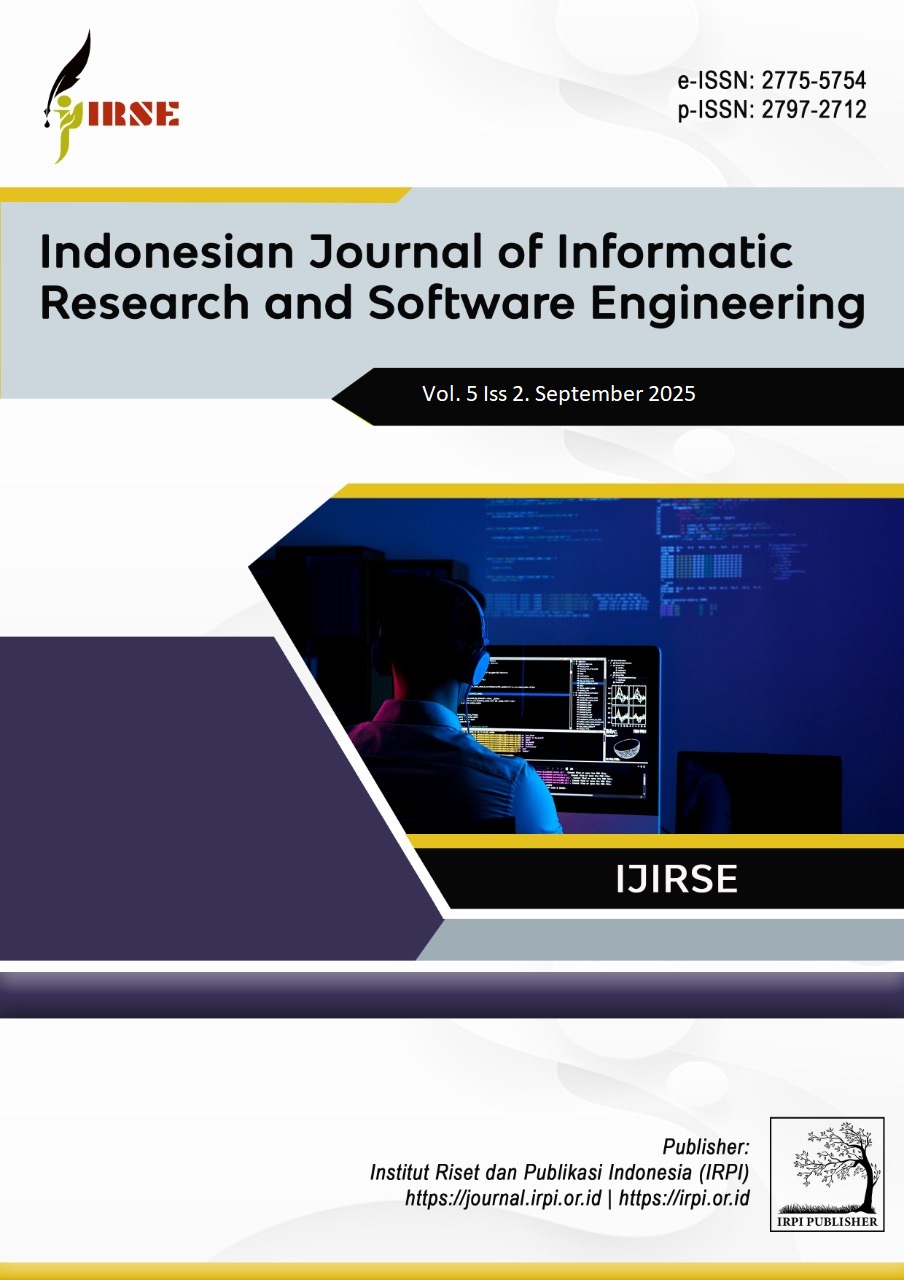Design of Artificial Immune System - Models and Algorithms
Design of Artificial Immune System - Models and Algorithms
DOI:
https://doi.org/10.57152/ijirse.v5i2.2246Keywords:
Artificial Immune System, Negative Selection, Artificial Immune Network, Clonal Selection, Dendritic CellAbstract
Artificial Immune Systems (AIS) belong to a group of computational intelligence methods inspired by the working mechanisms of biological immune systems to solve various computational problems. Artificial Neural Networks (ANNs) themselves are often used in various fields such as anomaly detection, pattern recognition, cyber and network security, task scheduling, process optimization, and data analysis, with the application of various ANN algorithms. In the AIS approach, there are four basic algorithms that serve as the main foundation, namely the Negative Selection Algorithm (NSA), Artificial Immune Networks (aiNet), Clonal Selection Algorithm (CLONALG), and Dendritic Cell Algorithm (DCA). The problem that occurs at this time is that there is still a lack of papers that discuss the main basic algorithms in AIS, resulting in difficulties in developing new models of basic algorithms. Apart from that, many other aspects of the natural immune system have not been touched due to not yet understanding the basic algorithm of AIS. This paper aims to explain the main models and algorithms in AIS above so that in future research, new algorithms can be developed based on the basic algorithm as a reference. The results of this paper are a review of the main basic models and algorithms in AIS.
References
M. Wang, S. Feng, C. He, Z. Li, and Y. Xue, “An Artificial Immune System Algorithm with Social Learning and Its Application in Industrial PID Controller Design,” Math. Probl. Eng., vol. 2017, no. 1, Jan. 2017, doi: 10.1155/2017/3959474.
S. Golzari, S. Doraisamy, M. N. B. Sulaiman, and N. I. Udzir, “A Review on Concepts, Algorithms and Recognition Based Applications of Artificial Immune System,” 2008, pp. 569–576. doi: 10.1007/978-3-540-89985-3_70.
M. Miralvand, S. Rasoolzadeh, and M. Majidi, “Proposing a features preprocessing method based on artificial immune and minimum classification errors methods,” J. Appl. Res. Technol., vol. 13, no. 4, pp. 477–481, Aug. 2015, doi: 10.1016/j.jart.2015.09.005.
C. J. Delona, P. V Haripriya, and J. S. Anju, “Negative selection algorithm: a survey,” Int. J. Sci. Eng. Technol. Res., vol. 6, no. 4, pp. 711–715, 2017.
P. H. Pandya, M. E. Murray, K. E. Pollok, and J. L. Renbarger, “The Immune System in Cancer Pathogenesis: Potential Therapeutic Approaches,” J. Immunol. Res., vol. 2016, pp. 1–13, 2016, doi: 10.1155/2016/4273943.
A. E. Thompson, “The Immune System,” JAMA, vol. 313, no. 16, p. 1686, Apr. 2015, doi: 10.1001/jama.2015.2940.
C. Nas, N. Putra, Y. G. Nengsih, and I. Syafrinal, “Artificial Immune System analysis on Route Construction distribution of gas cylinders using the AINet Algorithm,” J. Phys. Conf. Ser., vol. 1842, no. 1, p. 012001, Mar. 2021, doi: 10.1088/1742-6596/1842/1/012001.
M. G. Netea, A. Schlitzer, K. Placek, L. A. B. Joosten, and J. L. Schultze, “Innate and Adaptive Immune Memory: an Evolutionary Continuum in the Host’s Response to Pathogens,” Cell Host Microbe, vol. 25, no. 1, pp. 13–26, Jan. 2019, doi: 10.1016/j.chom.2018.12.006.
N. Rashid, J. Iqbal, F. Mahmood, A. Abid, U. S. Khan, and M. I. Tiwana, “Artificial Immune System–Negative Selection Classification Algorithm (NSCA) for Four Class Electroencephalogram (EEG) Signals,” Front. Hum. Neurosci., vol. 12, Nov. 2018, doi: 10.3389/fnhum.2018.00439.
N. Rai and A. Singh, “Improved Clonal Selection Algorithm (ICLONALG),” Int. J. Curr. Eng. Technol., vol. 5, no. 4, pp. 2459–2464, 2015, [Online]. Available: http://inpressco.com/category/ijcet
F. Zhu, W. Chen, H. Yang, T. Li, T. Yang, and F. Zhang, “A Quick Negative Selection Algorithm for One?Class Classification in Big Data Era,” Math. Probl. Eng., vol. 2017, no. 1, Jan. 2017, doi: 10.1155/2017/3956415.
R. Zhang, T. Li, and X. Xiao, “A Real-Valued Negative Selection Algorithm Based on Grid for Anomaly Detection,” Abstr. Appl. Anal., vol. 2013, pp. 1–15, 2013, doi: 10.1155/2013/268639.
C. Yang, L. Jia, B.-Q. Chen, and H.-Y. Wen, “Negative Selection Algorithm Based on Antigen Density Clustering,” IEEE Access, vol. 8, pp. 44967–44975, 2020, doi: 10.1109/ACCESS.2020.2976875.
Y. Li, D. Wang, Y. Yu, and L. Jiao, “An improved artificial immune network algorithm for data clustering based on secondary competition selection,” in 2016 IEEE Congress on Evolutionary Computation (CEC), IEEE, Jul. 2016, pp. 2744–2751. doi: 10.1109/CEC.2016.7744135.
Y. Zhong, L. Zhang, and W. Gong, “Unsupervised remote sensing image classification using an artificial immune network,” Int. J. Remote Sens., vol. 32, no. 19, pp. 5461–5483, Oct. 2011, doi: 10.1080/01431161.2010.502155.
H. N. Agiza, A. E. Hassan, and A. M. Salah, “An Improved Version of opt-aiNet Algorithm ( I-opt-aiNet ) for Function Optimization,” IJCSNS Int. J. Comput. Sci. Netw. Secur., vol. 11, no. 3, pp. 80–85, 2011.
X. Shi and F. Qian, “A multi-agent immune network algorithm and its application to Murphree efficiency determination for the distillation column,” J. Bionic Eng., vol. 8, no. 2, pp. 181–190, Jun. 2011, doi: 10.1016/S1672-6529(11)60024-3.
S. S. F. Souza, R. Romero, and J. F. Franco, “Artificial immune networks Copt-aiNet and Opt-aiNet applied to the reconfiguration problem of radial electrical distribution systems,” Electr. Power Syst. Res., vol. 119, pp. 304–312, Feb. 2015, doi: 10.1016/j.epsr.2014.10.012.
D. Q. Vu, V. T. Nguyen, and X. H. Hoang, “An improved artificial immune network for solving construction site layout optimization,” in 2016 IEEE RIVF International Conference on Computing & Communication Technologies, Research, Innovation, and Vision for the Future (RIVF), IEEE, Nov. 2016, pp. 37–42. doi: 10.1109/RIVF.2016.7800266.
C. Yang, B. Chen, L. Jia, and H. Wen, “Improved Clonal Selection Algorithm Based on Biological Forgetting Mechanism,” Complexity, vol. 2020, pp. 1–10, Apr. 2020, doi: 10.1155/2020/2807056.
W. Luo and X. Lin, “Recent advances in clonal selection algorithms and applications,” in 2017 IEEE Symposium Series on Computational Intelligence (SSCI), IEEE, Nov. 2017, pp. 1–8. doi: 10.1109/SSCI.2017.8285340.
X. Wang, A. S. Deshpande, G. B. Dadi, and B. Salman, “Application of Clonal Selection Algorithm in Construction Site Utilization Planning Optimization,” Procedia Eng., vol. 145, pp. 267–273, 2016, doi: 10.1016/j.proeng.2016.04.073.
B. S. Rao and K. Vaisakh, “Adaptive clonal selection algorithm for solving OPF problem with emission constraints,” in 2013 Annual IEEE India Conference (INDICON), IEEE, Dec. 2013, pp. 1–6. doi: 10.1109/INDCON.2013.6725969.
B. Haktanirlar Ulutas and S. Kulturel-Konak, “A review of clonal selection algorithm and its applications,” Artif. Intell. Rev., vol. 36, no. 2, pp. 117–138, Aug. 2011, doi: 10.1007/s10462-011-9206-1.
J. Greensmith, U. Aickelin, and G. Tedesco, “Information fusion for anomaly detection with the dendritic cell algorithm,” Inf. Fusion, vol. 11, no. 1, pp. 21–34, Jan. 2010, doi: 10.1016/j.inffus.2009.04.006.
N. Elisa, L. Yang, X. Fu, and N. Naik, “Dendritic Cell Algorithm Enhancement Using Fuzzy Inference System for Network Intrusion Detection,” in 2019 IEEE International Conference on Fuzzy Systems (FUZZ-IEEE), IEEE, Jun. 2019, pp. 1–6. doi: 10.1109/FUZZ-IEEE.2019.8859006.











